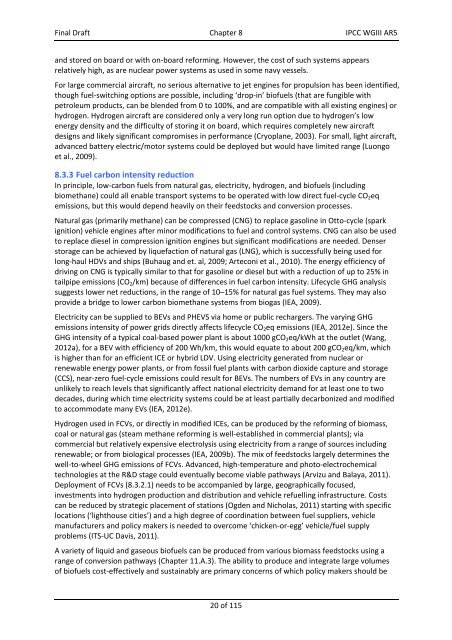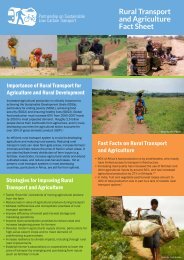ipcc_wg3_ar5_final-draft_postplenary_chapter8
ipcc_wg3_ar5_final-draft_postplenary_chapter8
ipcc_wg3_ar5_final-draft_postplenary_chapter8
Create successful ePaper yourself
Turn your PDF publications into a flip-book with our unique Google optimized e-Paper software.
Final Draft Chapter 8 IPCC WGIII AR5<br />
and stored on board or with on‐board reforming. However, the cost of such systems appears<br />
relatively high, as are nuclear power systems as used in some navy vessels.<br />
For large commercial aircraft, no serious alternative to jet engines for propulsion has been identified,<br />
though fuel‐switching options are possible, including ‘drop‐in’ biofuels (that are fungible with<br />
petroleum products, can be blended from 0 to 100%, and are compatible with all existing engines) or<br />
hydrogen. Hydrogen aircraft are considered only a very long run option due to hydrogen’s low<br />
energy density and the difficulty of storing it on board, which requires completely new aircraft<br />
designs and likely significant compromises in performance (Cryoplane, 2003). For small, light aircraft,<br />
advanced battery electric/motor systems could be deployed but would have limited range (Luongo<br />
et al., 2009).<br />
8.3.3 Fuel carbon intensity reduction<br />
In principle, low‐carbon fuels from natural gas, electricity, hydrogen, and biofuels (including<br />
biomethane) could all enable transport systems to be operated with low direct fuel‐cycle CO 2 eq<br />
emissions, but this would depend heavily on their feedstocks and conversion processes.<br />
Natural gas (primarily methane) can be compressed (CNG) to replace gasoline in Otto‐cycle (spark<br />
ignition) vehicle engines after minor modifications to fuel and control systems. CNG can also be used<br />
to replace diesel in compression ignition engines but significant modifications are needed. Denser<br />
storage can be achieved by liquefaction of natural gas (LNG), which is successfully being used for<br />
long‐haul HDVs and ships (Buhaug and et. al, 2009; Arteconi et al., 2010). The energy efficiency of<br />
driving on CNG is typically similar to that for gasoline or diesel but with a reduction of up to 25% in<br />
tailpipe emissions (CO 2 /km) because of differences in fuel carbon intensity. Lifecycle GHG analysis<br />
suggests lower net reductions, in the range of 10–15% for natural gas fuel systems. They may also<br />
provide a bridge to lower carbon biomethane systems from biogas (IEA, 2009).<br />
Electricity can be supplied to BEVs and PHEVS via home or public rechargers. The varying GHG<br />
emissions intensity of power grids directly affects lifecycle CO 2 eq emissions (IEA, 2012e). Since the<br />
GHG intensity of a typical coal‐based power plant is about 1000 gCO 2 eq/kWh at the outlet (Wang,<br />
2012a), for a BEV with efficiency of 200 Wh/km, this would equate to about 200 gCO 2 eq/km, which<br />
is higher than for an efficient ICE or hybrid LDV. Using electricity generated from nuclear or<br />
renewable energy power plants, or from fossil fuel plants with carbon dioxide capture and storage<br />
(CCS), near‐zero fuel‐cycle emissions could result for BEVs. The numbers of EVs in any country are<br />
unlikely to reach levels that significantly affect national electricity demand for at least one to two<br />
decades, during which time electricity systems could be at least partially decarbonized and modified<br />
to accommodate many EVs (IEA, 2012e).<br />
Hydrogen used in FCVs, or directly in modified ICEs, can be produced by the reforming of biomass,<br />
coal or natural gas (steam methane reforming is well‐established in commercial plants); via<br />
commercial but relatively expensive electrolysis using electricity from a range of sources including<br />
renewable; or from biological processes (IEA, 2009b). The mix of feedstocks largely determines the<br />
well‐to‐wheel GHG emissions of FCVs. Advanced, high‐temperature and photo‐electrochemical<br />
technologies at the R&D stage could eventually become viable pathways (Arvizu and Balaya, 2011).<br />
Deployment of FCVs (8.3.2.1) needs to be accompanied by large, geographically focused,<br />
investments into hydrogen production and distribution and vehicle refuelling infrastructure. Costs<br />
can be reduced by strategic placement of stations (Ogden and Nicholas, 2011) starting with specific<br />
locations (‘lighthouse cities’) and a high degree of coordination between fuel suppliers, vehicle<br />
manufacturers and policy makers is needed to overcome ‘chicken‐or‐egg’ vehicle/fuel supply<br />
problems (ITS‐UC Davis, 2011).<br />
A variety of liquid and gaseous biofuels can be produced from various biomass feedstocks using a<br />
range of conversion pathways (Chapter 11.A.3). The ability to produce and integrate large volumes<br />
of biofuels cost‐effectively and sustainably are primary concerns of which policy makers should be<br />
20 of 115



